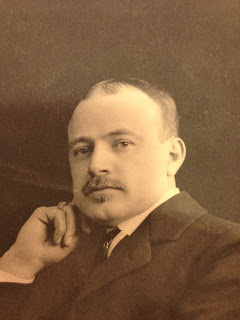Among the treasures my parents preserved is my father’s extraordinary, late 19th century baby book, The Baby’s Biography, by A.O. Kaplan. Remarkably, the evidence of the continued use of these three different surnames by a single family is recorded on one page of this book.
For decades, my grandmother, Blanche, a woman who died 17 years before my birth, meticulously kept a record of her son’s development in this baby book. Guided by the prompts in the table of contents, she saved a lock of my father’s hair, posted photos of James from infancy into his college years, and noted when James graduated from dresses to short pants to long trousers.
Weather clear and fine. temperature 44° F. outing lasted 15 minutes. Accompanied by mother and nurse. Route: from 54 West 71st, on South side of street eastward to 8th Ave, thence south on East side of 8th Ave to 68th st, retracing identical route. Effect of outing, favorable.
From a genealogical standpoint, one of the most significant entries is on page 15, “Naming of Baby”. Following traditional Jewish customs, on the eighth day following James’ birth, what presumably was a bris ceremony was performed at home. (And I write "presumably" as the term ‘bris’ is never used. Rather, exhibiting Victorian sensibilities, Blanche recorded the date in the entry for "Record of Religious Ceremonies" and described the event as “You Know!”)
At this religious ceremony, James formally received his name in the presence of 13 relatives. What is particularly striking about this page is the listing, on a single page, of the three variations of the maternal family surname: Kaliske, Sachs, and Saxe.
James’ maternal grandfather, Fabian Sachs (1833-1901), present at the bris, was born in Kalisz, Poland. At birth, his name was recorded Fabian Sax, although his father signed the birth register as S.H.Sachs (Szaja Hersz Sachs). The baby's name, Fabian Sax, is decipherable in the fifth line from the bottom in this birth register, written in Polish.
When Fabian immigrated to the United States about 1852, he and his brothers, Alexander (1835-1884) and Theodore (1827-1904), all used the surname Kaliske, a derivative of their birthplace, Kalisz. In an 1867 passport application, Fabian was using Sachs as a middle name, signing the application Fabian Sachs Kaliske.
In 1895, three years before the birth of his grandson, Fabian, through a legal filing, finally dropped Kaliske from his name, becoming known simply as Fabian Sachs. And that is how his name appears on page 15 of James’ baby book – Fabian Sachs. At that time, in 1898, his older brother, Theodore, is still using the surname Kaliske, as is Alexander's son, Albert S. Kaliske (1867-1949).
The Kaliske/Sachs name was next transformed into Saxe. Fabian was married twice, first in 1860 to Minna Rochotsh (1837-1866). In 1873, seven years after Minna’s death in childbirth, Fabian married Theresa Helburn (1855-1946). His two marriages produced six sons and two daughters between 1861 and 1882. By 1901 when Fabian wrote his will, seven of his eight children were using Saxe as their surname. Only the second-born son, Henry, continued to use the spelling of Sachs. Attending the bris on November 30, 1898 were the four full siblings of James’s mother, Blanche: Julian, Arthur, Belle, and Martin, as well as two of Blanche’s three half-brothers, Eugene and Sigmond.
The Sachs/Saxe family in Haines Falls, N.Y., 1896.Front row, left to right:Arthur Saxe, Martin Saxe, Julian SaxeMiddle row, left to right:Blanche Sachs Zweighaft, Theresa Helburn Sachs, Fabian Sachs, Belle SaxeBack row, left to right:Eugene Saxe, Sigmond Saxe, Henry Sachs
























